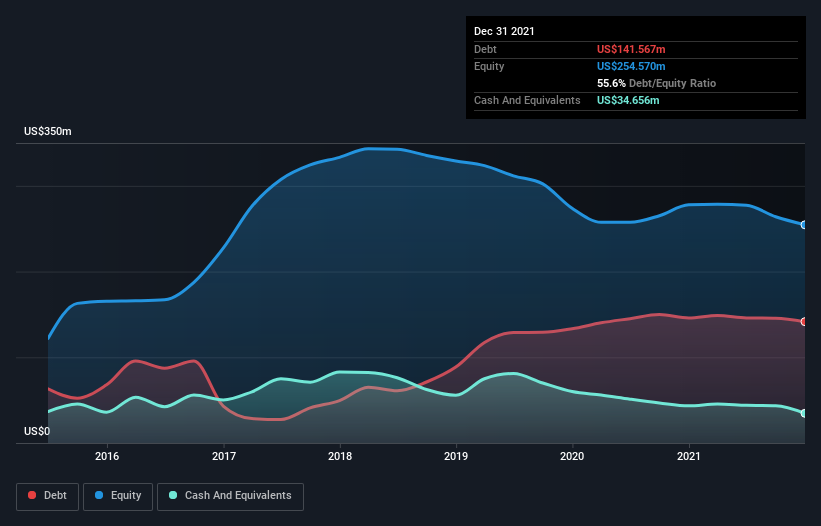- United States
- /
- Communications
- /
- NasdaqGM:AAOI
Is Applied Optoelectronics (NASDAQ:AAOI) Weighed On By Its Debt Load?

Howard Marks put it nicely when he said that, rather than worrying about share price volatility, 'The possibility of permanent loss is the risk I worry about... and every practical investor I know worries about.' When we think about how risky a company is, we always like to look at its use of debt, since debt overload can lead to ruin. We can see that Applied Optoelectronics, Inc. (NASDAQ:AAOI) does use debt in its business. But is this debt a concern to shareholders?
When Is Debt A Problem?
Debt assists a business until the business has trouble paying it off, either with new capital or with free cash flow. Part and parcel of capitalism is the process of 'creative destruction' where failed businesses are mercilessly liquidated by their bankers. However, a more frequent (but still costly) occurrence is where a company must issue shares at bargain-basement prices, permanently diluting shareholders, just to shore up its balance sheet. Of course, plenty of companies use debt to fund growth, without any negative consequences. When we examine debt levels, we first consider both cash and debt levels, together.
View our latest analysis for Applied Optoelectronics
What Is Applied Optoelectronics's Debt?
The chart below, which you can click on for greater detail, shows that Applied Optoelectronics had US$141.6m in debt in December 2021; about the same as the year before. However, it does have US$34.7m in cash offsetting this, leading to net debt of about US$106.9m.

How Healthy Is Applied Optoelectronics' Balance Sheet?
We can see from the most recent balance sheet that Applied Optoelectronics had liabilities of US$109.0m falling due within a year, and liabilities of US$90.9m due beyond that. Offsetting these obligations, it had cash of US$34.7m as well as receivables valued at US$56.1m due within 12 months. So its liabilities total US$109.1m more than the combination of its cash and short-term receivables.
The deficiency here weighs heavily on the US$68.8m company itself, as if a child were struggling under the weight of an enormous back-pack full of books, his sports gear, and a trumpet. So we definitely think shareholders need to watch this one closely. At the end of the day, Applied Optoelectronics would probably need a major re-capitalization if its creditors were to demand repayment. The balance sheet is clearly the area to focus on when you are analysing debt. But it is future earnings, more than anything, that will determine Applied Optoelectronics's ability to maintain a healthy balance sheet going forward. So if you're focused on the future you can check out this free report showing analyst profit forecasts.
In the last year Applied Optoelectronics had a loss before interest and tax, and actually shrunk its revenue by 9.8%, to US$212m. We would much prefer see growth.
Caveat Emptor
Importantly, Applied Optoelectronics had an earnings before interest and tax (EBIT) loss over the last year. Indeed, it lost a very considerable US$57m at the EBIT level. When we look at that alongside the significant liabilities, we're not particularly confident about the company. We'd want to see some strong near-term improvements before getting too interested in the stock. Not least because it burned through US$22m in negative free cash flow over the last year. That means it's on the risky side of things. There's no doubt that we learn most about debt from the balance sheet. But ultimately, every company can contain risks that exist outside of the balance sheet. These risks can be hard to spot. Every company has them, and we've spotted 4 warning signs for Applied Optoelectronics you should know about.
If, after all that, you're more interested in a fast growing company with a rock-solid balance sheet, then check out our list of net cash growth stocks without delay.
If you're looking to trade Applied Optoelectronics, open an account with the lowest-cost platform trusted by professionals, Interactive Brokers.
With clients in over 200 countries and territories, and access to 160 markets, IBKR lets you trade stocks, options, futures, forex, bonds and funds from a single integrated account.
Enjoy no hidden fees, no account minimums, and FX conversion rates as low as 0.03%, far better than what most brokers offer.
Sponsored ContentNew: Manage All Your Stock Portfolios in One Place
We've created the ultimate portfolio companion for stock investors, and it's free.
• Connect an unlimited number of Portfolios and see your total in one currency
• Be alerted to new Warning Signs or Risks via email or mobile
• Track the Fair Value of your stocks
Have feedback on this article? Concerned about the content? Get in touch with us directly. Alternatively, email editorial-team (at) simplywallst.com.
This article by Simply Wall St is general in nature. We provide commentary based on historical data and analyst forecasts only using an unbiased methodology and our articles are not intended to be financial advice. It does not constitute a recommendation to buy or sell any stock, and does not take account of your objectives, or your financial situation. We aim to bring you long-term focused analysis driven by fundamental data. Note that our analysis may not factor in the latest price-sensitive company announcements or qualitative material. Simply Wall St has no position in any stocks mentioned.
About NasdaqGM:AAOI
Applied Optoelectronics
Designs, manufactures, and sells fiber-optic networking products in the United States, Taiwan, and China.
Exceptional growth potential with adequate balance sheet.
Similar Companies
Market Insights
Community Narratives



